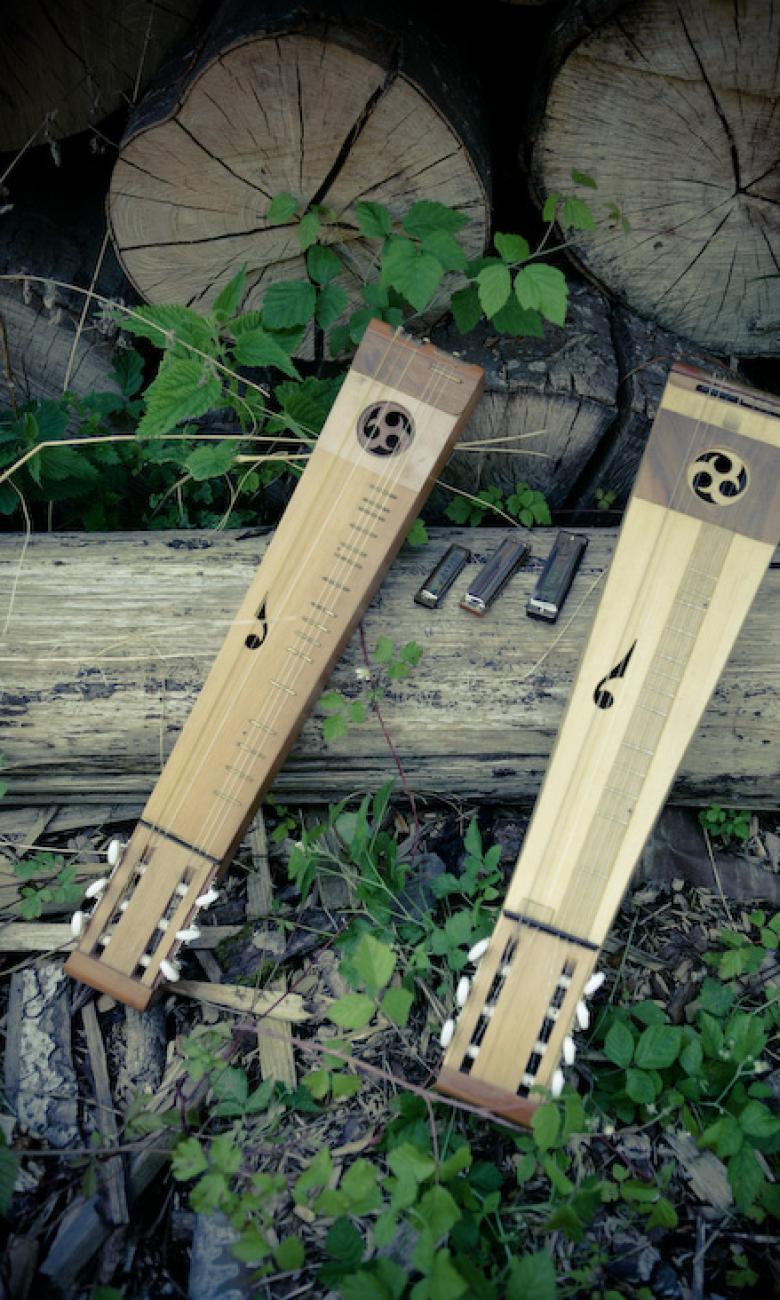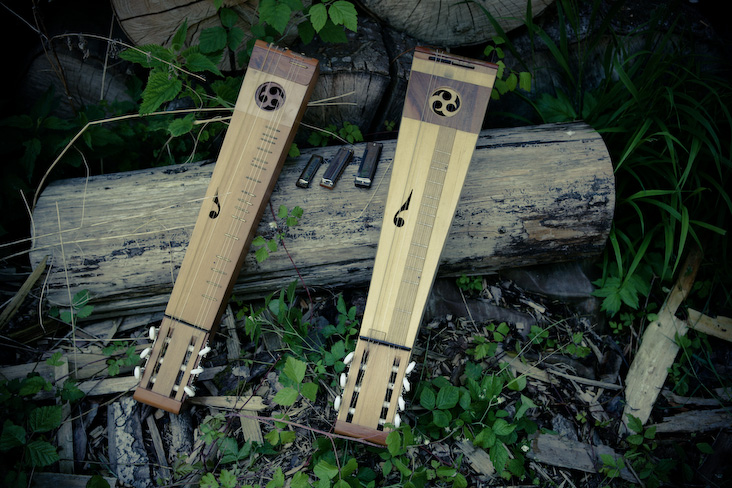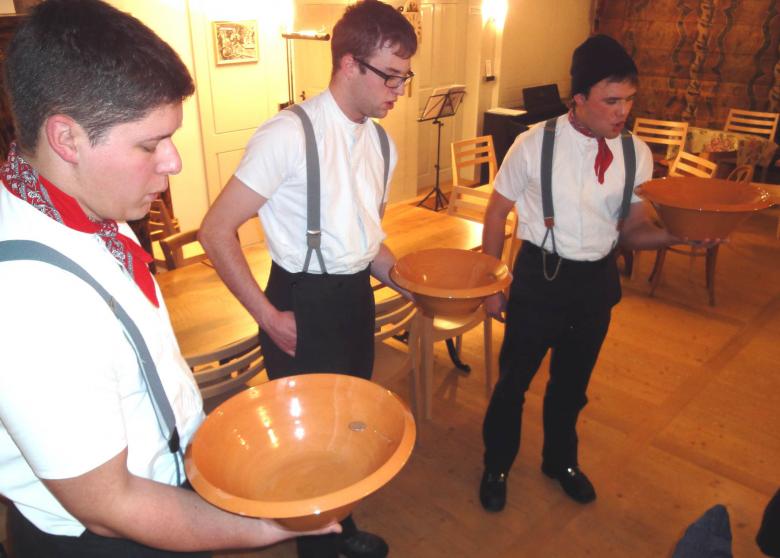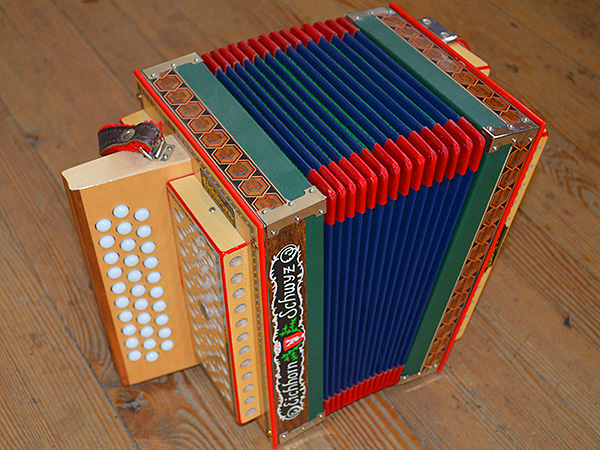Swiss folk music: 5 traditional instruments
Yodelling, the iconic style of song that echoes through the Swiss mountains, is well known, as is the accordion and the alphorn. However, there are other original instruments in the Swiss folk tradition. Here is a non-exhaustive inventory.
A wide variety of string and wind instruments lend their rich tones to the traditional music of the country. Some of them are rooted in a particular canton or region, and have therefore remained relatively unknown outside of regional borders. Other instruments, however, such as the hackbrett or the schwyzerörgeli, have escaped from the confines of folklore and entered into music academies, where they are in demand as concert instruments among certain composers. Let's look at five remarkable Swiss instruments.

The büchel
Everyone knows the alphorn, with its deep tones that carry for kilometres in all directions. Its cousin the büchel, which has a particularly strong presence in central Switzerland, is less well known, however. It is a type of alphorn that is shaped like a bugle, although it is fashioned from pinewood and is shorter and more flared. It is held like a trumpet. In contrast to the alphorn, the büchel isn't straight; there are two coils in the pipe. It has a clearer and sharper tone than the alphorn and can produce rapid sequences of notes. It is, however, a difficult instrument to master, with changes of pitch produced exclusively by the positioning of the musician's lips on the mouthpiece of the instrument.

The hexenscheit and other Swiss zithers
The hexenscheit, or in Swiss German 'Häxeschit', meaning literally 'witch's board', is a Bernese instrument from the zither family. It is an older and simpler version of the zither, and produces a metallic sound. The strings are plucked with the fingers. There are a wide variety of zithers in Switzerland, including versions from Glarus or from Schwyz; some of them are finely crafted and decorated. The instrument has been present in the country for almost 200 years. It is the shape of a trapezoid, and is generally played laid on one's lap or on a table, although the Toggenburg and the Kriens zithers are held like guitars. There is a museum devoted entirely to Swiss zithers, exhibiting some one hundred instruments, at Trachselwald in the Emmenthal valley (canton of Bern).

The hackbrett
Characterised by its unique sound, this instrument is similar to the cimbalom that is popular in gypsy music, although it is of a smaller size. It is traditionally associated with the canton of Appenzell but can also be found in Valais. In contrast to the hexenscheit, the strings of the hackbrett are not plucked; instead, they are struck with two hammers. It can also be played with four hands by two musicians facing each other. As the length of the strings determines the pitch of the sound, the hackbrett's sound box is the shape of a trapezoid. The strings are divided into segments by bridges that enable the musician to produce different notes. The version from Appenzell traditionally comprises 25 courses of 5 strings, all tuned to the same pitch. The hackbrett from Valais is smaller and has fewer courses and strings. Cimbaloms can be found in numerous countries, particularly in the East and in Eastern Europe. So how did they reach Switzerland? An article from the Revue Musicale Suisse (Swiss Music Guide) suggests that they were brought here by Austrian musicians. The first reference to the hackbrett in Switzerland occurs in 1447 in a Zurich police report about a night disturbance! One of the oldest surviving Swiss hackbretts, dating from 1820, is exhibited in the Swiss Music Museum in Basel.

Unusual percussion instruments: wooden spoons and talerschwingen
Swiss folk music is also characterised by the inventive appropriation of domestic objects. This is true, for example, of the wooden or metal spoons that are used for percussion and can accompany accordion tunes. The playing technique involves holding two spoons by their handles and striking them rhythmically on one's thighs or forearms. Spoon playing was first attested in Switzerland in the late eighteenth century. Until the 1970s, metal soup spoons were used; however, since then, researchers such as Brigitte Bachmann-Geiser, an ethnologist who specialises in Swiss folk music, have observed a growing craze for carved wooden spoons. This improvised instrument has become a fashionable means of percussion that can be bought in music shops or ordered made to measure from a craftsman. A further instrument fashioned from whatever was to hand, talerschwingen involves rotating a five franc coin in a bowl. It first appeared some time after 1900 in the canton of Appenzell and the Toggenburg region. The player rolls the coin slowly in an earthenware bowl, and bowls with three different diameters are used in order to vary the tone, which brings to mind the sound of cow bells!

The schwyzerörgeli, or the Schwyz accordion
The sound of this little accordion is characteristic of Swiss folk melodies and of Ländler (Swiss country dance) music. It is known as the 'schwyzerörgeli' because it first appeared the canton of Schwyz in 1886, having been adapted by Alois Eichhorn from a Viennese instrument that arrived in Switzerland at the beginning of the nineteenth century. This diatonic accordion enables the musician to play the bass and the melody by means of 18 buttons for the left hand and 31 for the right. If you wish to know more, you should watch the documentary Fremdfötzelige Musikanten (Peculiar Musicians), produced by Roger Bürgler in 2015, which uncovers the history of this instrument and introduces some innovative players of the schwyzerörgeli who are anything but conventional musicians!





